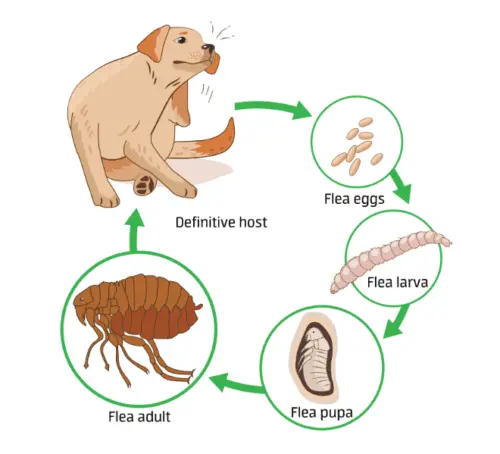Mosquito Joe explains why flea larvae identification is crucial for pest control.
|
Fleas are bothersome insects that feed on the blood of humans and animals. If you’re a pet owner, you’ve likely experienced or feared the presence of fleas, which can spread quickly and be difficult to get rid of. Fleas are commonly brought into your home on your pets, so you should check your furry friends frequently to spot early signs of a flea problem. Learn more about what flea larvae look like and your flea control options with help from the pest control experts at Mosquito Joe®!
What Are Flea Larvae?
Adult female fleas lay eggs after they feed. A single female flea can lay up to 50 eggs per day, contributing to a quickly developing flea infestation. These eggs then hatch in one to 12 days, forming flea larvae. Some people think they look like very skinny maggots with their slim, worm-shaped bodies. They start off white or transparent until they eat flea dirt and become darker.
After feeding for around five to 20 days, flea larvae then enter the next stage of their lifecycle. They will spin a silk-like cocoon, where they develop into an adult flea. Adult fleas appear much different than flea larvae, with flat bodies, six legs, mouths, bristles, and a brownish-black appearance. It can take weeks or months for adult fleas to hatch.
Key Characteristics of Flea Larvae
To identify flea larvae, you’ll need to know what it looks like. You may be wondering, what color are flea larvae, or how big are flea larvae? They are usually around ¼-inch (two to five millimeters) long and pale white or translucent. They are wormlike and don’t have any legs or eyes. They can be extremely hard to see, especially when they burrow.
Depending on when they last fed, flea larvae could appear darker. They eat flea dirt, which is blood-filled feces from adult fleas. We know, gross! The flea dirt can be seen in their gut through their translucent skin, giving them a brownish-black appearance. Consider checking out flea larvae images online to help you identify these pests in your home.
Where Can You Find Flea Larvae?
When fleas are in the egg or larvae stage, they fall off of your pet and are often in areas where your dog or cat lays or sleeps. They will burrow into carpets, pet bedding, and furniture. You may also find them wherever there are cracks and crevices, like baseboards or cushion edges. Outside, you can find fleas in shady and moist areas like under trees, under your patio, in thick grass, within compost piles, in mulch, and burrowed in organic matter.
If you suspect your pet may have fleas, the parasites can often be found in warm, protected areas. Check your pet’s belly, armpits, and around the base of their tail. You can also check along their back and neck.
How to Get Rid of Flea Larvae
To get rid of flea larvae, you can do the following:
- Vacuum: Thoroughly vacuum carpets, baseboards, furniture, and other areas where flea larvae could collect. Use the highest suction possible, and make sure you empty the vacuum bag when finished.
- Wash items in hot water: Wash pet bedding, throw rugs, blankets, and any other items that you can in hot water. Consider washing your pet’s padding regularly as a precautionary measure.
- Use flea traps and sprays: Many different types of flea traps, sprays, and other treatments can be used within your home to get rid of flea larvae. You can even make your own spray with vinegar, water, lemon juice, and witch hazel.
- Treat your yard for fleas: You can also help prevent flea larvae in your home by treating your yard. Mosquito Joe offers flea control services you can count on, backed by the Neighborly Done Right Promise® and the Mosquito Joe Satisfaction Guarantee.
When it comes to pests, it can be effective to combine your own at-home measures with professional treatments. Explore all of Mosquito Joe’s pest control services, and give us a call today to get a free estimate!
Identifying Fleas Larvae vs. Other Pests
While it can be difficult to tell fleas apart from other types of pests. However, there are distinct visual characteristics and behaviors to help you make the distinction:
- Fleas vs. ticks: Fleas are smaller than ticks, teardrop-shaped, feed very quickly, and jump around, preferably within warm and humid environments. Ticks are larger, do not jump, feed slowly, and are more likely to be found in wooded areas and tall grasses.
- Fleas vs. carpet beetles: Carpet beetles are bigger and rounder than fleas, tend not to bite, and are commonly found in dark areas like attics or basements.
- Fleas vs. bedbugs: Fleas and bedbugs can be hard to tell apart, but while fleas are elongated and more common on animals, bed bugs are oval-shaped and more common near humans.
- Fleas vs. lice: Fleas will jump and move quickly between hosts, usually animals. Lice are more likely to crawl around and tend to prefer human hosts.
- Fleas vs. fungus gnats: The main difference between fleas and fungus gnats is that fungus gnats have long legs and wings to fly. Fleas are wingless and rely on crawling.
- Fleas vs. maggots: Flea larvae and maggots differ mostly based on behavior. Fleas are in moist, warm areas, usually where pets are. Maggots are attracted to decaying matter and can be found near trash or feces.
When dealing with fleas, it’s important Be sure to keep the flea’s lifecycle in mind. They will behave and look differently as they transition into adult fleas.
Steps to Help Prevent Flea Infestations
Fleas can be extremely bothersome to animals and humans. Their bites can cause irritation, discomfort, and itching. In serious situations, they can also lead to infection or severe allergic reactions. Fleas also present the risk of disease transmission and anemia in pets from excessive feeding and blood loss. Here are some tips to help combat flea infestations:
- Ask your vet about flea treatment for your pets
- Regularly vacuum your home and empty the bag or canister after each use
- Regularly wash pet bedding and other areas where flea larvae could collect
- Regularly bathe and brush your pets, especially after spending time outside
- Check your pets frequently for fleas and ticks
- Inspect your pets, carpets, and furniture for fleas and other pests
- Consider insecticides and eco-friendly flea deterrents
- Consult with a professional to learn more about flea treatments for your property
If you have questions about fleas and other pests in and outside of your home, contact Mosquito Joe today. Our trained professionals are here to answer any questions you may have. Locally owned and operated, we’re dedicated to helping you achieve a bite-free lifestyle. With traditional and eco-friendly pest control solutions, we have no contracts, and your satisfaction is guaranteed. Don’t delay — take action today against fleas and other bothersome pests!
This article is intended for general informational purposes only and may not be applicable to every situation. You are responsible for determining the proper course of action for your home and property. Mosquito Joe is not responsible for any damages that occur as a result of this blog content or your actions. For the most accurate guidance, contact your local Mosquito Joe location for a comprehensive, on-site assessment.

